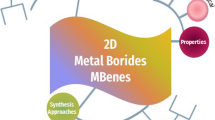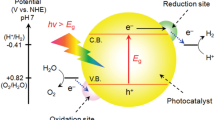Abstract
Layered BiOBr-BiOI composites with tunable bandgap were deposited onto ZnO nanowire arrays by spin-coating. The prepared BiOBr-BiOI/ZnO heterostructures were characterized by X-ray diffraction, scanning electron microscopy, transmission electron microscopy, UV-visible absorption, and photoelectrochemical response. The bandgap of the BiOBr-BiOI can be tuned by varying the ratio of BiOBr/BiOI. The BiOBr-BiOI composites were proved to be n-type semiconductors, which serve as sensitizers in the BiOBr-BiOI/ZnO heterostructures. BiOBr-BiOI/ZnO heterostructures show much higher visible light photoelectrochemical activity than ZnO nanowire arrays because of the visible light absorption of BiOBr-BiOI and the formation of heterojunction between BiOBr-BiOI and ZnO, which reduces the recombination of photogenerated electrons and holes. In addition, the bandgap of BiOBr-BiOI directly affects the photoelectrochemical performance of the BiOBr-BiOI/ZnO heterojunctions. The smaller bandgap of the BiOBr-BiOI is, the more visible light is absorbed and the higher photoelectrochemical performance of the BiOBr-BiOI/ZnO heterojunctions achieves. The BiOBr-BiOI/ZnO heterostructures can be developed for application in water splitting and other optoelectrical devices.








Similar content being viewed by others
References
Gratzel M (2001) Photoelectrochemical cells. Nature 414:338–344
Murphy AB, Barnes PRF, Randeniya LK, Plumb IC, Grey IE, Horne MD, Glasscock JA (2006) Efficiency of solar water splitting using semiconductor electrodes. Int J Hydrog Energy 31:1999–2017
Zhang WD, Xu B, Jiang LC (2010) Functional hybrid materials based on carbon nanotubes and metal oxides. J Mater Chem 20:6383–6391
Tryk DA, Fujishima A, Honda K (2000) Recent topics in photoelectrochemistry: achievements and future prospects. Electrochim Acta 45:2363–2376
Hu YS, Kleiman-Shwarsctein A, Forman AJ, Hazen D, Park JN, McFarland EW (2008) Pt-doped alpha-Fe2O3 thin films active for photoelectrochemical water splitting. Chem Mater 20:3803–3805
Beermann N, Vayssieres L, Lindquist SE, Hagfeldt A (2000) Photoelectrochemical studies of oriented nanorod thin films of hematite. J Electrochem Soc 147:2456–2461
Shankar K, Basham JI, Allam NK, Varghese OK, Mor GK, Feng XJ, Paulose M, Seabold JA, Choi KS, Grimes CA (2009) Recent advances in the use of TiO2 nanotube and nanowire arrays for oxidative photoelectrochemistry. J Phys Chem C 113:6327–6359
Lai CW, Sreekantan S (2013) Incorporation of WO3 species into TiO2 nanotubes via wet impregnation and their water-splitting performance. Electrochim Acta 87:294–302
Kosanovic T, Karoussos D, Bouroushian M (2010) CdSe electrodeposition on anodic, barrier or porous Ti oxides. A sensitization effect. J Solid State Electrochem 14:241–248
Kalanur SS, Hwang YJ, Chae SY, Joo OS (2013) Facile growth of aligned WO3 nanorods on FTO substrate for enhanced photoanodic water oxidation activity. J Mater Chem A 1:3479–3488
Su JZ, Feng XJ, Sloppy JD, Guo LJ, Grimes CA (2011) Vertically aligned WO3 nanowire arrays grown directly on transparent conducting oxide coated glass: synthesis and photoelectrochemical properties. Nano Lett 11:203–208
Lade SJ, Uplane MD, Lokhande CD (2001) Photoelectrochemical properties of CdX (X = S, Se, Te) films electrodeposited from aqueous and non-aqueous baths. Mater Chem Phys 68:36–41
Jahagirdar AH, Dhere NG (2007) Photoelectrochemical water splitting using CuIn(1-x)GaxS(2)/CdS thin-film solar cells for hydrogen generation. Sol Energy Mater Sol Cells 91:1488–1491
Oh I, Kye J, Hwang S (2012) Enhanced photoelectrochemical hydrogen production from silicon nanowire array photocathode. Nano Lett 12:298–302
Mayer MT, Du C, Wang DW (2012) Hematite/Si nanowire dual-absorber system for photoelectrochemical water splitting at low applied potentials. J Am Chem Soc 134:12406–12409
Saito R, Miseki Y, Sayama K (2013) Photoanode characteristics of multi-layer composite BiVO4 thin film in a concentrated carbonate electrolyte solution for water splitting. J Photochem Photobiol A 258:51–60
Zhou M, Bao J, Bi WT, Zeng YQ, Zhu R, Tao MS, Xie Y (2012) Efficient water splitting via a heteroepitaxial BiVO4 photoelectrode decorated with Co-Pi catalysts. Chemsuschem 5:1420–1425
Gurunathan K, Maruthamuthu P (1998) Bi5Nb3O15 as a photocatalyst: photocatalytic and photoelectrochemical studies. J Solid State Electrochem 2:176–180
Law M, Greene LE, Johnson JC, Saykally R, Yang PD (2005) Nanowire dye-sensitized solar cells. Nat Mater 4:455–459
Zhang WD, Jiang LC, Ye JS (2009) Photoelectrochemical study on charge transfer properties of ZnO nanowires promoted by carbon nanotubes. J Phys Chem C 113:16247–16253
Mo GQ, Ye JS, Zhang WD (2009) Unusual electrochemical response of ZnO nanowires-decorated multiwalled carbon nanotubes. Electrochim Acta 55:511–515
Hsu YK, Lin CM (2012) Enhanced photoelectrochemical properties of ternary Zn1-xCuxO nanorods with tunable band gaps for solar water splitting. Electrochim Acta 74:73–77
Zhong M, Li YB, Yamada I, Delaunay JJ (2012) ZnO-ZnGa2O4 core-shell nanowire array for stable photoelectrochemical water splitting. Nanoscale 4:1509–1514
Jiang LC, Zhang WD, Yu YX, Wang J (2011) Preparation and charge transfer properties of carbon nanotubes supported CdS/ZnO-NWs shell/core heterojunction. Electrochem Commun 13:627–630
Hahn NT, Hoang S, Self JL, Mullins CB (2012) Spray pyrolysis deposition and photoelectrochemical properties of n-type BiOI nanoplatelet thin films. ACS Nano 6:7712–7722
Zhao LJ, Zhang XC, Fan CM, Liang ZH, Han PD (2012) First-principles study on the structural, electronic and optical properties of BiOX (X = Cl, Br, I) crystals. Physica B 407:3364–3370
Zhang L, Cao XF, Chen XT, Xue ZL (2011) BiOBr hierarchical microspheres: microwave-assisted solvothermal synthesis, strong adsorption and excellent photocatalytic properties. J Colloid Interface Sci 354:630–636
Zhang J, Shi FJ, Lin J, Chen DF, Gao JM, Huang ZX, Ding XX, Tang CC (2008) Self-assembled 3-D architectures of BiOBr as a visible light-driven photocatalyst. Chem Mater 20:2937–2941
Ye LQ, Tian LH, Peng TY, Zan L (2011) Synthesis of highly symmetrical BiOI single-crystal nanosheets and their 001 facet-dependent photoactivity. J Mater Chem 21:12479–12484
Xiao X, Zhang WD (2010) Facile synthesis of nanostructured BiOI microspheres with high visible light-induced photocatalytic activity. J Mater Chem 20:5866–5870
Li P, Zhao X, Jia CJ, Sun HG, Sun LM, Cheng XF, Liu L, Fan WL (2013) ZnWO4/BiOI heterostructures with highly efficient visible light photocatalytic activity: the case of interface lattice and energy level match. J Mater Chem A 1:3421–3429
Li HQ, Cui YM, Hong WS (2013) High photocatalytic performance of BiOI/Bi2WO6 toward toluene and Reactive Brilliant Red. Appl Surf Sci 264:581–588
Cao J, Li X, Lin HL, Xu BY, Chen SF, Guan QM (2013) Surface acid etching of (BiO)(2)CO3 to construct (BiO)(2)CO3/BiOX (X = Cl, Br, I) heterostructure for methyl orange removal under visible light. Appl Surf Sci 266:294–299
Ye LQ, Liu JY, Gong CQ, Tian LH, Peng TY, Zan L (2012) Two different roles of metallic Ag on Ag/AgX/BiOX (X = Cl, Br) visible light photocatalysts: surface plasmon resonance and Z-scheme bridge. ACS Catal 2:1677–1683
Tu XM, Luo SL, Chen GX, Li JH (2012) One-pot synthesis, characterization, and enhanced photocatalytic activity of a BiOBr-graphene composite. Chem Eur J 18:14359–14366
Dai GP, Yu JG, Liu G (2011) Synthesis and enhanced visible-light photoelectrocatalytic activity of p-n junction BiOI/TiO2 nanotube arrays. J Phys Chem C 115:7339–7346
Zhang X, Zhang LZ, Xie TF, Wang DJ (2009) Low-temperature synthesis and high visible-light-induced photocatalytic activity of BiOI/TiO2 heterostructures. J Phys Chem C 113:7371–7378
Jiang J, Zhang X, Sun PB, Zhang LZ (2011) ZnO/BiOI heterostructures: photoinduced charge-transfer property and enhanced visible-light photocatalytic activity. J Phys Chem C 115:20555–20564
Xu CK, Shin P, Cao LL, Gao D (2010) Preferential growth of long ZnO nanowire array and its application in dye-sensitized solar cells. J Phys Chem C 114:125–129
Yoon KH, Seo DK, Cho YS, Kang DH (1998) Effect of Pt layers on the photoelectrochemical properties of a WO3/p-Si electrode. J Appl Phys 84:3954–3959
Yoon KH, Shin CW, Kang DH (1997) Photoelectrochemical conversion in a WO3 coated p-Si photoelectrode: effect of annealing temperature. J Appl Phys 81:7024–7029
Kunadian I, Lipka SM, Swartz CR, Qian D, Andrews R (2009) Determination of carrier densities of boron- and nitrogen-doped multiwalled carbon nanotubes using Mott-Schottky plots. J Electrochem Soc 156:K110–K115
Khan SUM, Akikusa J (1999) Photoelectrochemical splitting of water at nanocrystalline n-Fe2O3 thin-film electrodes. J Phys Chem B 103:7184–7189
Jaramillo TF, Baeck SH, Kleiman-Shwarsctein A, Choi KS, Stucky GD, McFarland EW (2005) Automated electrochemical synthesis and photoelectrochemical characterization of Zn1-xCoxO thin films for solar hydrogen production. J Comb Chem 7:264–271
Li TB, Chen G, Zhou C, Shen ZY, Jin RC, Sun JX (2011) New photocatalyst BiOCl/BiOI composites with highly enhanced visible light photocatalytic performances. Dalton Trans 40:6751–6758
Cao J, Xu BY, Luo BD, Lin HL, Chen SF (2011) Novel BiOI/BiOBr heterojunction photocatalysts with enhanced visible light photocatalytic properties. Catal Commun 13:63–68
Acknowledgments
The authors thank the National Natural Science Foundation of China (no. 21003051, 21273080, and 21043005) for financial support.
Author information
Authors and Affiliations
Corresponding authors
Rights and permissions
About this article
Cite this article
Yu, YX., Ouyang, WX. & Zhang, WD. Photoelectrochemical property of the BiOBr-BiOI/ZnO heterostructures with tunable bandgap. J Solid State Electrochem 18, 1743–1750 (2014). https://doi.org/10.1007/s10008-014-2402-6
Received:
Revised:
Accepted:
Published:
Issue Date:
DOI: https://doi.org/10.1007/s10008-014-2402-6




